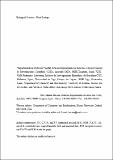Por favor, use este identificador para citar o enlazar a este item:
http://hdl.handle.net/10261/45057COMPARTIR / EXPORTAR:
 SHARE SHARE
 CORE
BASE CORE
BASE
|
|
| Visualizar otros formatos: MARC | Dublin Core | RDF | ORE | MODS | METS | DIDL | DATACITE | |

| Título: | Leghemoglobin green derivatives with nitrated hemes evidence production of highly reactive nitrogen species during aging of legume nodules |
Autor: | Navascués Ortega, Joaquín CSIC; Pérez-Rontomé, Carmen CSIC ORCID ; Gay, Marina CSIC ORCID; Marcos, Manuel; Yang, Fei; Walker, F. Ann; Desbois, Alain; Abián, Joaquín CSIC ORCID; Becana Ausejo, Manuel CSIC ORCID | Fecha de publicación: | feb-2012 | Editor: | National Academy of Sciences (U.S.) | Citación: | Navascués J, Pérez-Rontomé C, Gay M, Marcos M, Yang F, Walker FA, Desbois A, Abián J, Becana M. Leghemoglobin green derivatives with nitrated hemes evidence production of highly reactive nitrogen species during aging of legume nodules. Proceedings of the National Academy of Sciences of the United States of America (PNAS) 109 (7): 2660-2665 (2012) | Resumen: | Globins constitute a superfamily of proteins widespread in all kingdoms of life, where they fulfill multiple functions, such as efficient O2 transport and modulation of nitric oxide bioactivity. In plants, the most abundant Hbs are the symbiotic leghemoglobins (Lbs) that scavenge O2 and facilitate its diffusion to the N2-fixing bacteroids in nodules. The biosynthesis of Lbs during nodule formation has been studied in detail, whereas little is known about the green derivatives of Lbs generated during nodule senescence. Here we characterize modified forms of Lbs, termed Lbam, Lbcm, and Lbdm, of soybean nodules. These green Lbs have identical globins to the parent red Lbs but their hemes are nitrated. By combining UV-visible, MS, NMR, and resonance Raman spectroscopies with reconstitution experiments of the apoprotein with protoheme or mesoheme, we show that the nitro group is on the 4-vinyl. In vitro nitration of Lba with excess nitrite produced several isomers of nitrated heme, one of which is identical to those found in vivo. The use of antioxidants, metal chelators, and heme ligands reveals that nitration is contingent upon the binding of nitrite to heme Fe, and that the reactive nitrogen species involved derives from nitrous acid and is most probably the nitronium cation. The identification of these green Lbs provides conclusive evidence that highly oxidizing and nitrating species are produced in nodules leading to nitrosative stress. These findings are consistent with a previous report showing that the modified Lbs are more abundant in senescing nodules and have aberrant O2 binding. | Descripción: | 1 art. (21 pags., 4 Figs.) + Supplemental Information (13 Pags., 3 Tabls, 6 Figs.). The definitive version is available at: http://www.pnas.org/ | Versión del editor: | http://dx.doi.org/10.1073/pnas.1116559109 | URI: | http://hdl.handle.net/10261/45057 | DOI: | 10.1073/pnas.1116559109 | ISSN: | 0027-8424 | E-ISSN: | 1091-6490 |
| Aparece en las colecciones: | (EEAD) Artículos |
Ficheros en este ítem:
| Fichero | Descripción | Tamaño | Formato | |
|---|---|---|---|---|
| BecanaM_PNAS_2012.pdf | Artículo | 1,24 MB | Adobe PDF |  Visualizar/Abrir |
| BecanaM_PNAS_2012-Supp_Inf.pdf | Información suplementaria | 904,31 kB | Adobe PDF |  Visualizar/Abrir |
CORE Recommender
PubMed Central
Citations
23
checked on 24-abr-2024
SCOPUSTM
Citations
69
checked on 24-abr-2024
WEB OF SCIENCETM
Citations
65
checked on 29-feb-2024
Page view(s)
548
checked on 24-abr-2024
Download(s)
463
checked on 24-abr-2024
Google ScholarTM
Check
Altmetric
Altmetric
Artículos relacionados:
NOTA: Los ítems de Digital.CSIC están protegidos por copyright, con todos los derechos reservados, a menos que se indique lo contrario.
